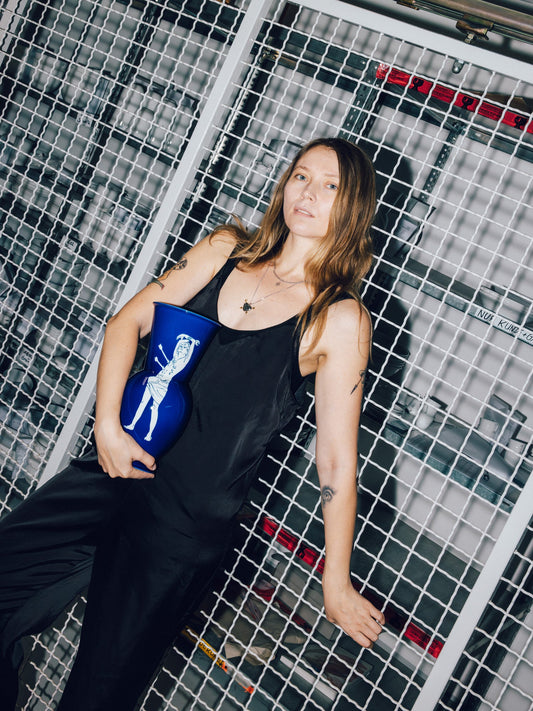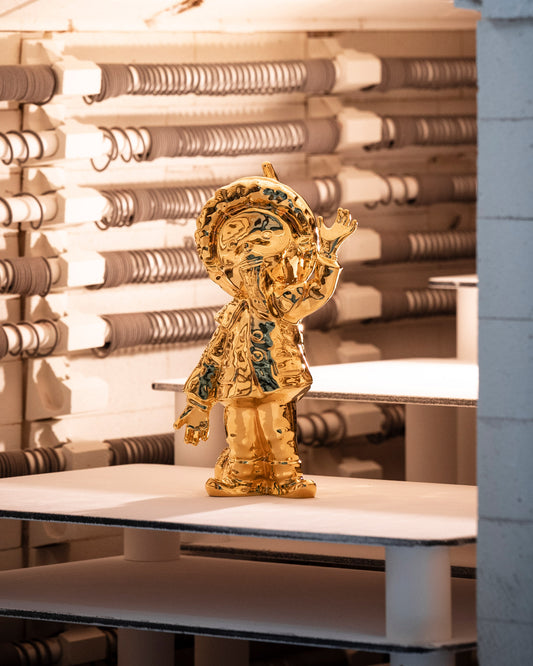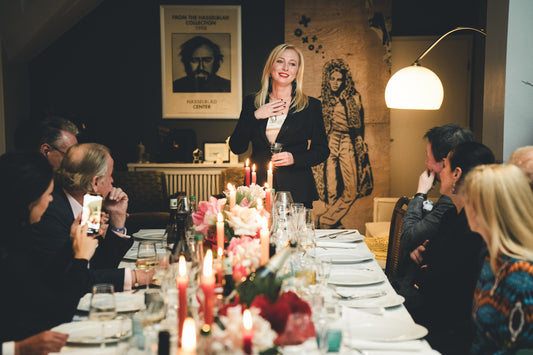THE POETRY OF PORCELAIN
KPM Berlin regularly maintains an exchange with important creative minds of our time. The most recent cooperation brought them together with the design studio New Tendency: a conversation from our customer magazine WEISS No. 3 about Bauhaus, plates and creative processes
The design studio in a Kreuzberg backyard at Kottbusser Tor is not easy to find. Only an inconspicuous sign reveals that one of the city's hippest design labels is located here: New Tendency. Behind it are the designers Manuel Goller and Sebastian Schönheit, who have known each other since their studies, and Manuel's brother Christoph Goller, who is responsible for the operational and financial side of the business. The three of them work with two other employees in a light-flooded factory floor, where they work on their designs in a concentrated and calm manner. The products are manufactured by their partners, as all their design objects are created in close cooperation with artists, architects and manufacturers. New Tendency mainly develops furniture. One of its best-known products is the "Meta" side table made of folded steel. It stands for a design that plays with perspectives and proportions, with filigree and solid forms. New Tendency has now made a name for itself internationally and sells its furniture from New York to Tokyo.
Occasionally, however, the design trio also ventures into other areas. The collaboration with KPM Berlin began a year and a half ago, and it "clicked immediately", as Manuel Goller says. The 34-year-old has always been fascinated by the eventful history of the porcelain manufactory and its current endeavors to enrich the traditional brand with contemporary influences. Together with KPM head designer Thomas Wenzel, they set to work - with the aim of not shying away from any challenge and pushing the boundaries of what is possible when it comes to porcelain. The result? Floating beauty!
Mr. Goller, you studied at the Bauhaus University in Weimar. How did the Bauhaus influence you?
For me, the idea of Bauhaus was the greater inspiration than the formal language. On the one hand, there was the collective collaboration: in the 1920s in Weimar, very different players came together and worked together on a larger idea. Secondly, it was about questioning the status quo: the Bauhaus members were not satisfied with what was. They saw themselves as pioneers, tried out new things, broke with the old and thought them through further.
Are these the reasons why the Bauhaus still seems so relevant after 100 years?
The players were way ahead of their time. I don't know if we are as avant-garde in design today as we were back then. Today, we tend to quote or refer to what already exists, but not in such a radically new way.
Keyword: collective cooperation. How did the cooperation with KPM come about?
We have always been fascinated by KPM. It is a manufactory, comparable to the Bauhaus workshops, a place where people produce beautiful things.
You say that design can create cultural values. What do you mean by that?
Our aim is to create timeless life companions that people can identify with. Objects that inspire and give pleasure through their aesthetics and feel, in addition to their pure function.
How do you approach your designs?
We don't want to create purely functional design objects, but lively products with an expressive character. This is also the basis for deciding whether or not to publish a particular product. It may work in terms of design or handling, but if it lacks personality, we prefer to take our time and develop the design further.
KPM also creates cultural assets . . Yes, KPM has this claim. That's why the collaboration was a good fit right from the start. The exciting thing is that people immediately understand the character of an object, even non-verbally. When they see a product from us or from KPM, they immediately develop a relationship with the object.
You often talk about poetry. How much poetry is there in porcelain?
Porcelain is a very poetic material. It changes during the creative process. The development of porcelain is like a biography: the first state is almost liquid, then it becomes almost leathery, but still malleable, then it is pre-fired and suddenly shrinks. And in the end, it acquires that firmness, that unique feel for which we love porcelain. A very lively material - and each object is unique.
Is porcelain a new material for you?
Yes, it contrasts with the materials we normally work with: Aluminum and steel. That's why porcelain is so exciting for us.
KPM and New Tendency have jointly developed a design study for a plate that will go into production. Why a plate?
We want to design things that you use every day, that are taken for granted and enrich everyday life. The plate is a good example: you don't just use it once a day, but probably three times.
What is the design idea behind this plate?
We tried to rethink the plate and combine it with Japanese influences. It was about creating a stage or setting - for a beautiful dish prepared with love, for example - and honoring the culinary creation.
How did you implement the idea?
We have developed an exceptionally high base. This creates a drop shadow under the plate - and the plate appears to float. The shape is delicate and flat. From the front, it looks almost like a Japanese serving tray in a double-T shape, very transparent. If you turn the plate, it is completely closed. And from above you can see the perfect circle.
If you stack the plates on top of each other, they form their own shape, almost like a sculpture . . . Yes, the object should not only function on its own, but also in a multitude. We made a very precise cut in the middle of the round base of the plate to emphasize the lightness of the plate. This is a design element that we play with in almost all of our objects: the contrast between very delicate and very solid shapes.
The "Edition 2020" of the collaboration is limited to 20 highly exclusive sets of five plates each and can be pre-ordered now at preorder@kpm-berlin.com. Price on request.
Text: Heike Gläser
Images: Jonas Lindstroem, PR, New Tendency


